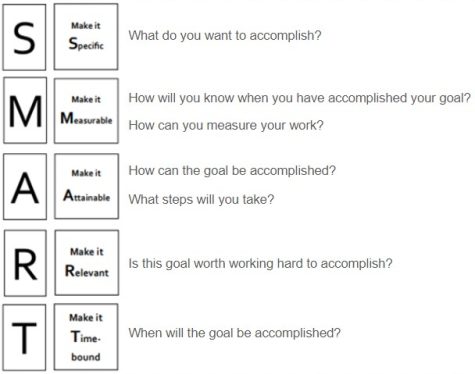You can do it!

February 17, 2023
What do you hope to achieve?
Improved attendance? Passing grades? Graduation? A job? A career? A well-paying career?
Is your end goal to better manage your emotions? Overcome an obstacle or barrier?
How do you achieve this? Will you achieve it by waiting for it to happen? NO!
You need to take STEPS to MAKE it happen!
So where do you start?
Start with short-term goals.
There are 5 components to successful goal-setting to help you achieve what you set out to obtain.
Setting Specific, Measurable, Achievable, Relevant, and Time-bound (SMART) objectives is a good way to plan the steps to meet your long-term goals!
S: Specific
In order for a goal to be effective, it needs to be specific. A specific goal answers questions like:
What needs to be accomplished?
Who’s responsible for it?
What steps need to be taken to achieve it?
Thinking through these questions helps get to the heart of what you’re aiming for.
M: Measurable
Being specific is a solid start, but quantifying your goals (that is, making sure they’re measurable) makes it easier to track progress and know when you’ve reached the finish line.
For example, if your goal is to pass all classes this semester, you will need to measure progress throughout the semester with your grades in Home Access Center. If you’re failing assignments for weeks, it will be hard to bring up your grade at the end of the quarter! Measure the progress along the way!
A: Achievable
This is the point in the process when you give yourself a serious reality check. Goals should be realistic. Ask yourself: is your objective something you can reasonably accomplish? Maybe a goal of straight As is unreasonable but a goal of passing all classes is something you can achieve. Don’t set goals unreasonably high and set yourself up for failure (no pun intended).
R: Relevant
Here’s where you need to think about the big picture. Why are you setting the goal that you’re setting? How does it contribute to your longer-term goals?
T: Time-bound
How will you know when you’ve reached your goal? Establish times when you will check-in with yourself to see how you’re doing.
So where do you start?
Ask yourself: Where am I right now in terms of my goal? What steps do I need to take to get closer to my goal? Is there anyone who can help me achieve my goal or keep me accountable?
 You can use this template to help you set SMART goals and work toward achieving them!
You can use this template to help you set SMART goals and work toward achieving them!
Enlist the help of your friends, trusted adults, teachers, and counselors to help you stay on track and you’ll be on your way to success!